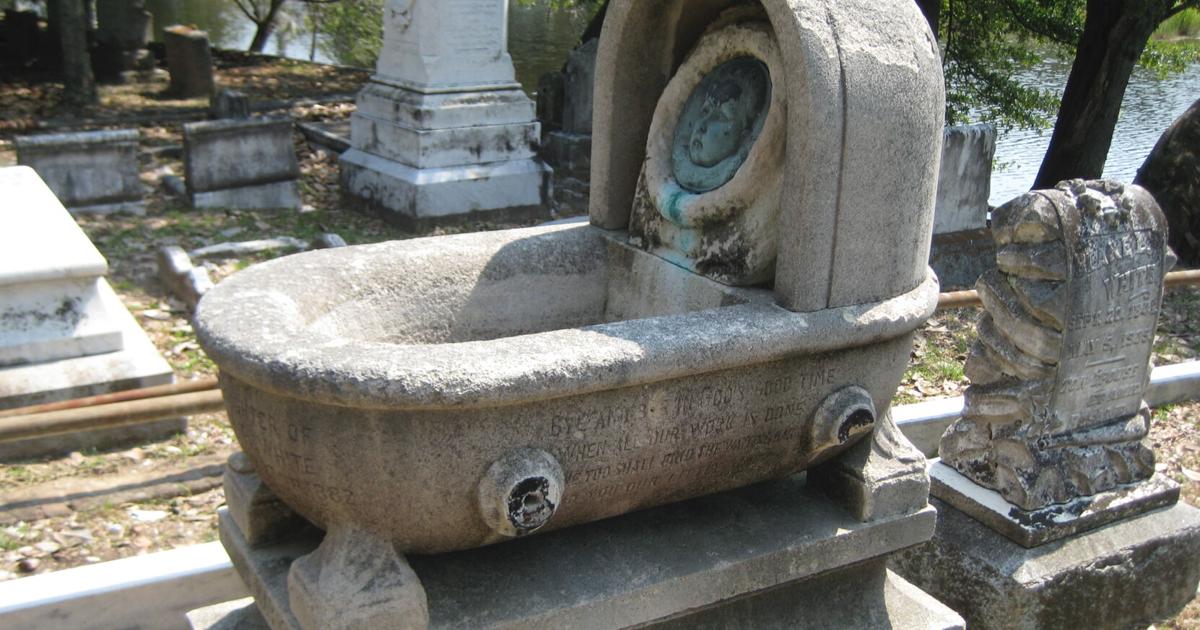This infant grave is one of many infants and children buried at Magnolia Cemetery. This monument to Rosalie Raymond White is one of the most unusual, with a death mask in a bassinette. The child died in 1882 when she was seven months old. There were eight children born to this family, only three would live to adulthood. (Photo taken in July 1994).
Magnolia Cemetery
Cunnington Avenue
vs. 1849
Listed on the National Register of Historic Places, 1978.
By the mid-19th century, Charleston had become the twelfth largest city in the United States. Not everyone had a long life back then; life expectancy at birth was about 40 years for males and 42 years for females. An expanding population meant rising death rates. City cemeteries, where most of the deceased were buried, were forced to continually reallocate burial spaces. Not a comforting thought for those seeking a final resting place.
Embalming had not become normal practice until after the Civil War; it was not uncommon to see mourners in cemeteries holding a handkerchief so as not to inhale the foul smells emanating from the graves. There were always fears in fever-ridden Charleston that cemeteries could be places to spread disease and contaminate water.
These urban conflicts advanced the idea, not only in Charleston but throughout America, of viewing the pastoral outskirts of cities and towns as perfect places to bury the rested.
Designed in the English landscape tradition, the tombs were to be part of a peaceful, lush garden with picturesque bucolic views. In the Victorian era, as part of the romantic art movement of rural cemeteries, funerary architecture became an expression of evolving cultural and religious ideas about death and assurances of eternal life. Ornate statuary, mausoleums and monuments became ornate expressions of a family’s wealth and importance in the community. Rural cemeteries were designed to be popular civic places for family picnics and walks.
Magnolia Cemetery was founded in 1850 on an area of the former Magnolia Umbra rice plantation. The original plantation house (circa 1790), Colonel William Cunnington’s house remains. The cemetery with 92 acres of upland and 58 acres of marsh on the Cooper River was designed by Charleston architect Edward C. Jones in 1849. He divided the cemetery into neighborhoods with named streets winding along the lakes and through mature gardens. There was a stable (demolished in the 1970s) and a Gothic-style steeple chapel (circa 1851) demolished after 1865.
There are 35,000 people buried in Magnolia Cemetery, including 1,700 Confederate soldiers and sailors. Lt. George E. Dixon and a crew of seven volunteers were lost when the Confederate submarine Hunley went down on February 17, 1864. The wreckage was salvaged in 2000, the remains of the eight-man crew were later recovered buried on April 17. , 2004.
Other historic cemeteries near Magnolia: Saint-Laurent — Catholic (1851); Kahal Kadosh Beth Elohim – Jewish (1887); Bethany – Lutheran (1856); Brown Fellowship Society – free people of color (1794), moved from Pitt Street in 1956.

